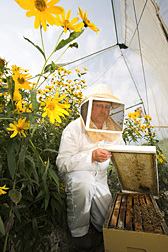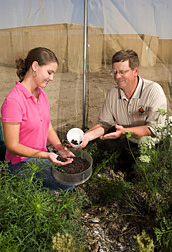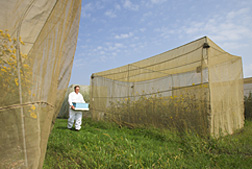Proving Their Prowess—
Insects Help Preserve Germplasm Collection
|
|
Entomologist Steve Hanlin often finds himself sharing his workspace with 5,000 honey bees.
“You need to approach them calmly,” observes his colleague, technician Sharon McClurg. “And you have to be careful what you lean up against.”
Hanlin and McClurg wrangle other pollinators as well. It’s all part of a plan to protect the genetic purity of more than 49,000 plant accessions maintained at the North Central Regional Plant Introduction Station (NCRPIS) in Ames, Iowa. The station maintains numerous germplasm collections belonging to the National Plant Germplasm System, which is administered by the Agricultural Research Service.
Hanlin and McClurg manage colonies of several insects for pollinating certain plants in the germplasm collections during their controlled seed increase, or “grow-out.” During this period, curators cultivate plants to obtain seeds that contain the same distinct genetic characteristics as their parent material.
|
|
Grow-outs sometimes take place within field cages and greenhouses designed to shelter the emerging plants. This ensures that seeds or clonal materials contained in the NCRPIS collections are capable of germinating, or are viable. NCRPIS provides this germplasm for research and educational purposes—in 2006, some 20,000 packets of seeds were sent to scientists around the world.
In most cases, seeds won’t develop without pollination, and if just any insect were to pollinate these accessions in the open, genetic havoc could ensue. Enclosing the plants in a screened space with a selected insect pollinator keeps other insects out and guarantees that only the selected insect will carry out pollination—one that can do the job.
NCRPIS Pollinators—The A list
Honey bees (Apis mellifera) have been the heavy hitters since 1957, when NCRPIS began its controlled-pollination program. They are used in about 700 field and greenhouse cages year-round.
Hanlin ensures that there are enough honey bees to meet demand. In a building with a faint aroma of beeswax, he hand-assembles a “nuc”—short for nucleus—which will contain an assortment of worker bees and an introduced queen bee. After 2 weeks, if the workers and queen have set up shop—as indicated by the presence of eggs or larvae—he’ll place the nuc in a field cage so that the bees can get to work.
Though colony collapse disorder (CCD) has resulted in heavy honey bee losses for some beekeepers in the United States, the honey bees at Ames have not been affected yet. But even before CCD emerged as a problem, NCRPIS staff always looked for opportunities to diversify the pollinators they used.
More Placid Pollinators
Under the direction of NCRPIS research leader Candice Gardner, McClurg has worked with Hanlin since 2004 to integrate another pollinator into the mix. The alfalfa leafcutting bee (Megachile rotundata) is already a favorite of alfalfa producers. Hanlin and McClurg buy 16 gallons of alfalfa leafcutting bee pupae—at 10,000 pupae per gallon—every year.
They have devised a staged system for nurturing the pupae—which arrive wrapped up in leaf cells created by adult bees the previous growing season—through their emergence as new adults ready for action. Nonstinging and more docile than honey bees, the solitary alfalfa leafcutting bees perform best in hot, dry weather.
At NCRPIS, two species of mason bees—the hornfaced bee (Osmia cornifrons) and the blue orchard bee (Osmia lignaria)—stay busy even when some other pollinators find fluctuating springtime temperatures too cool. Though mason bees are nonstinging and easy to rear in captivity, they are creatures of habit and will only pollinate from April until June.
To create a nesting domicile for the mason bees, Hanlin tucks about 40 paper straws inside a plastic pipe. In autumn, he checks to see whether the straws are capped with mud, which is a signal that larvae are protected within. Domiciles with larvae are put in cold incubation until they are needed in the spring. Then the domiciles are placed in field cages, where the adults emerge.
“Mason bees don’t like being moved around, either,” Hanlin says. “Once I’ve put their domicile in a field cage, it has to stay put—or else they won’t work.”
Bees That Like a Challenge
Sometimes only the big guys will do. Though bumble bees (Bombus impatiens) are adept at pollinating many plants, at NCRPIS they are usually paired with plants that are just plain difficult—for example, ornamentals with trumpet-shaped flowers.
Bumble bees are tricky to rear in captivity, so Hanlin procures them from an outside supplier. Mildly aggressive, they will sting if provoked. But the benefit from these bees outweighs the cost. They work year round, can be moved from cage to cage, put in long hours each day, and keep going even in cool, cloudy weather.
|
|
A Pest Becomes Productive
Flies don’t mean to pollinate. It’s just something they do while they’re doing something else—flying from flower to flower to find the perfect resting spot.
In cages, these lazy flies are particularly good at partnering with honey bees to pollinate carrots and other plants in the carrot family. Two kinds of flies—blue bottle flies (Calliphora sp.) and house flies (Musca domestica)—have been put to work at NCRPIS.
Entomology and curatorial staff collaborated in establishing flies as pollinators, which are acquired as pupae from an outside vendor. “They’re very successful,” McClurg says. “They provide plant curators with a short-term pollinator that isn’t expensive.”
Because house flies have a limited life span, the lab replenishes around 80 cages with about 10,000 new flies every week in the summer. The pace slows in fall and winter to around 5,000 a week. Blue bottle flies last longer in the cages, but more complete pollination occurs when both species are present.
These insects earn their keep, but they can’t escape their reputation. “Flies are flies,” Hanlin concedes. “Some people do find them irritating.”
Kathy Reitsma, one of the NCRPIS plant curators, is pleased with how well the pollination program has worked out. “There are pros and cons to each pollinator,” she says. “We know we can always pollinate the plants by hand if insect pollinators are not available, but we prefer to use insects whenever possible.”—By Ann Perry, Agricultural Research Service Information Staff.
This research is part of Plant Genetic Resources, Genomics, and Genetic Improvement, an ARS national program (#301) described on the World Wide Web at www.nps.ars.usda.gov.
Steve Hanlin, Sharon McClurg, Candice Gardner, and Kathy Reitsma are with the North Central Regional Plant Introduction Station, State and Mortensen Roads, Ames, IA 50011; phone (515) 294-1936 [Hanlin], (515) 294-4004 [McClurg], (515) 294-7967 [Gardner], (515) 294-3212 [Reitsma], fax (515) 294-1903.
"Proving Their Prowess—Insects Help Preserve Germplasm Collection" was published in the May/June 2008 issue of Agricultural Research magazine.














